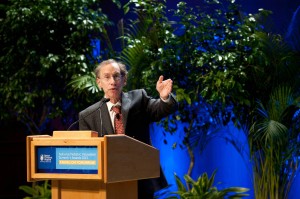 When James Mandell, MD, outgoing CEO of Boston Children’s Hospital, introduced keynote speaker Robert Langer, PhD, at the National Pediatric Innovation Summit + Awards, he shared one of Langer’s favorite quotes. “When scientific literature says something isn’t possible, you just have to create possibilities that don’t exist.”
When James Mandell, MD, outgoing CEO of Boston Children’s Hospital, introduced keynote speaker Robert Langer, PhD, at the National Pediatric Innovation Summit + Awards, he shared one of Langer’s favorite quotes. “When scientific literature says something isn’t possible, you just have to create possibilities that don’t exist.”
Langer, the David H. Koch Institute Professor at the Massachusetts Institute of Technology (MIT) and the most cited engineer in history, walked the audience through the trials and tribulations he encountered in his four-decade career as an innovator.
When he finished his ScD in chemical engineering in 1974, Langer was heavily courted by the oil and gas industries, which aimed to leverage the knowledge of young chemical engineers to address the oil crisis. But that work didn’t appeal to him.
Instead, Langer was taken with the idea of teaching chemistry to underserved youth. Unfortunately, he could not secure a position with any of the 40-odd programs to which he applied.
Eventually, a colleague suggested to him that Judah Folkman, MD, a pioneering cancer researcher at Boston Children’s, sometimes hired “interesting people.” Langer took the bait and joined Folkman’s lab in the mid-1970s.
“I may have been the only engineer in the place. I learned so much because everyone’s backgrounds were so different,” he recalled.
Missions impossible?
Folkman’s visionary nature fueled Langer’s passion for innovation. “He believed almost anything is possible for a young scientist,” Langer said.
But when Folkman assigned Langer his first major project—to isolate angiogenesis inhibitors that would starve tumors of their blood supply—the duo encountered roadblock after roadblock.
The first challenge was logistics. Folkman thought that cartilage, which loses its blood vessels after the embryonic period, might contain angiogenesis inhibitors. To look for them, Langer needed animal cartilage and lots of it. The conventional solution―rabbit cartilage―didn’t yield enough for their needs. Cows provided a slightly better source. Langer eventually teamed with local meat packing plants, which provided ample cartilage for the research.
The second roadblock wasn’t quite so simple. Langer needed to develop bioassays to test potential angiogenesis inhibitors. They required slow release of compounds that would stimulate angiogenesis in cartilage, followed by inhibitors that would stop the vessels from growing.
Colleague after colleague informed Langer that his proposed method wasn’t workable, pointing out two well-accepted facts: Large molecules cannot slowly diffuse through solid polymers, and organic solvents will denature peptides or proteins.
Langer plugged away for two years, discovering more than 200 ways the method would not work, all opportunities for learning. Ultimately, perseverance paid off, and the team developed an angiogenesis assay and published the research in Science in 1976.
It took 28 years and billions of dollars before the first angiogenesis inhibitor (Bevacizumab/Avastin) was approved. Today, multiple angiogenesis inhibitors have been approved for clinical use, and all have been isolated using Langer’s assays.
Langer continued to take on impossible missions. For example, annually for six years, he submitted a patent application to put insulin in polymers, ignoring the advice of a lawyer who urged him to abandon the project. He ultimately succeeded, this time by combing through the scientific literature, locating his detractors and asking them to affirm their skepticism—unintentionally supporting his patent application by demonstrating the uniqueness of the invention for patent purposes.
When the private companies that licensed the innovation didn’t follow through with commercializing the concept, Langer started his own company.
He continued to model innovation throughout his career, and today has more than 815 issued or pending patents worldwide.
Langer concluded with a few words of advice for the audience.
Role models can help establish a culture of innovation, he said. Although he found it unsettling to start his own company 30 years ago, it paved the way for post-docs and graduate students to follow in his footsteps. “When people see others they know doing something, [it reduces barriers].”







